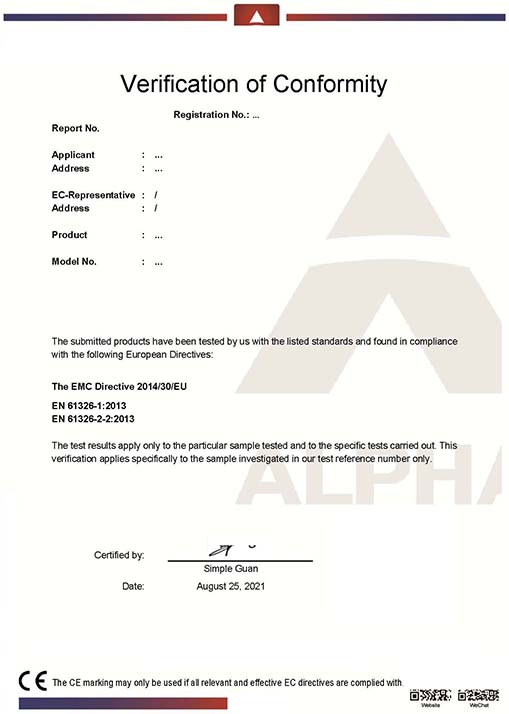On September 1, 2020, the British government officially announced that the UK had left the EU. The UK Conformity Assessment (UKCA) certification mark will be officially used from January 1, 2021. However, a one-year transition period is stipulated, that is, before January 1, 2022, the CE mark can still be used. After January 1, 2022, the UK will no longer recognize the CE mark. Only if the product bears the UKCA mark and complies with the relevant rules of the United Kingdom can the product with the CE mark be sold in the United Kingdom, that is, under the condition that the UK and EU regulations are met at the same time and no shielding is allowed, the CE and UKCA marks can be used on the product at the same time.
UKCA mark is a new British product mark, which will be used for products sold in the UK (England, Wales and Scotland) market. It covers most of the goods previously requiring CE mark. The UKCA logo does not apply to goods sold on the Northern Ireland market. After the UK UKCA logo is implemented, the export of products that originally only required CE certification to the EU and the UK will require CE and UKCA certification respectively, which may have a significant impact on the product cost of enterprises and needs to be highly concerned.
[Coverage]
The UKCA logo can be used on the certificate in the following cases:
Scenario 1
The UKCA mark is required by law, and a third party is required to conduct conformity assessment. The UKCA mark will be used.
Scenario 2
The UKCA mark is required by law, but it is not mandatory for a third party to conduct conformity assessment. The UKCA mark will be used. Such certificates are voluntary third-party compliance certificates (AoC for short).
The specific situation of the product shall be determined by reference to the conformity assessment mode specified in the applicable British regulations for the corresponding product. Generally, when the evaluation mode is Class A, it is applicable to the above 2 cases, and when the evaluation mode is not Class A, it is applicable to the above 1 cases.
For example, the current UK:
According to the Electrical Products (Safety) Regulations 2016, the compliance assessment mode is Class A (internal production control) |
[EMC Regulations 2016] stipulates that the conformity assessment mode is Class A (internal production control), or Class B (type inspection)+Class C (internal production control) |
[Wireless Product Regulations 2017] stipulates that the conformity assessment mode is Class A (internal production control), or Class B (type inspection)+Class C (internal production control), or Class H (total quality assurance) |
[Machine (Safety) Regulations 2008] stipulates that the conformity assessment mode is Class A (internal production control) for products not in Annex IV, or Class B (type inspection)+Class C (internal production control), or Class H (overall quality assurance) for products in Annex IV |
How to use the UKCA logo?
The conformity assessment procedure of UKCA mark is basically the same as that required by CE mark. The certification points to be noted are:
1: Designate an authorized representative or person in charge in the United Kingdom. From January 1, 2021, the United Kingdom will no longer recognize the authorized representative or person in charge in the EU.
2: Products with UKCA logo must have the UK DoC signed by the manufacturer or its authorized representative. The information required for the UK DoC is basically the same as that currently required for the EU DoC. The difference is that the UK DoC should list UK regulations (see Table 1) rather than EU regulations; The standards specified in the UK (BS standards) shall be used instead of those referenced in the EU OJ.
Note: DOC is the Declaration of Conformity and OJ is the official journal.
Comparison Table of EU Legislation and UK Legislation | |
EU legislation | UK legislation |
Toy Safety - Directive 2009/48/EC | Toys (Safety) Regulations 2011 |
Recreational craft and personal watercraft - Directive 2013/53/EU | Recreational Craft Regulations 2017 |
Simple Pressure Vessels - Directive 2014/29/EU | Simple Pressure Vessels (Safety) Regulations 2016 |
Electromagnetic Compatibility - Directive 2014/30/EU | Electromagnetic Compatibility Regulations 2016 |
Low Voltage Directive 2014/35 | Electrical Equipment (Safety) Regulations 2016 |
Non-automatic Weighing Instruments - Directive 2014/31/EU | Non-automatic Weighing Instruments Regulations 2016 |
Measuring Instruments - Directive 2014/32/EU | Measuring Instruments Regulations 2016 |
Lifts - Directive 2014/33/EU | Lifts Regulations 2016 |
ATEX - Directive 2014/34/EU | Equipment and Protective Systems Intended for use in Potentially Explosive Atmospheres Regulations 2016 |
Radio equipment - Directive 2014/53/EU | Radio Equipment Regulations 2017 |
Pressure equipment - Directive 2014/68/EU | Pressure Equipment (Safety) Regulations 2016 |
Personal protective equipment - Regulation (EU) 2016/425 | Personal Protective Equipment Regulations (Regulation (EU) 2016/425 as brought into GB law and amended) and the Personal Protective Equipment (Enforcement) Regulations 2018 |
Gas appliances - Regulation (EU) 2016/426 | Gas Appliances Regulation (Regulation (EU) 2016/426 as brought into GB law and amended) Appliances (Enforcement) and Miscellaneous Amendment Regulations 2018 |
Machinery Directive 2006/42/EC | Supply of Machinery (Safety) Regulations 2008 |
Outdoor Noise Directive 2000/14/EC | Noise Emission in the Environment by Equipment for use Outdoors Regulations 2001 |
Ecodesign Directive 2009/125/EC | The Ecodesign for Energy- Related Products Regulations 2010 |
Energy Labelling Regulation (EU) 2017/1369 | Regulation (EU) 2017/1369 |
Restriction of the Use of certain Hazardous Substances in Electrical and Electronic Equipment(RoHS)- Directive 2011/65/EU | The Restriction of the Use of Certain Hazardous Substances in Electrical and Electronic Equipment Regulations 2012 |
Directive 2013/29/EU- Pyrotechnic Articles | The Pyrotechnic Articles (Safety) Regulations 2015 |
[Certificate Template]
